Note from Admin: Today, we have a really, really cool and neat guest post from Jed Orme. Jed is a Fuji X user and he’s been experimenting a lot with adapting different types of lenses to his X-E2. In this article, he’s adapted a vintage Fujinon SLR lens to his camera. If you’re a fan of the X Series, you should definitely take a look at this article! Thanks, Jed!
A Lens Not Too Far! (Another Adapted Lens for Fuji X) :
A while back, Patrick graciously permitted me to offer an article for his blog about my experiences in adapting two very special lenses for use with my Fuji X-E2 camera system. These were a Leica Tele-Elmarit 90mm f2.8 & a Zeiss Planar T 50mm f2, both adapted by using Fuji’s X to M lens mount adapter. I can only say that my foray into this world of using adapted glass on my Fuji has proved most enjoyable, & only whetted my appetite to see what else there might be out there. Turns out the options are practically limitless (virtually every old SLR film camera lens ever made almost), & there are adapter mounts made for a great number of them.
But my interests were confined only to those lenses that were primarily made for use on rangefinder type cameras, with the standard being those that could currently be used on the newer digital Leicas. Of course, that still offers a very large universe to choose from. However, in addition to the two adapted lenses mentioned above, I currently employ these Fuji XF lenses made especially for their X system cameras: their 14mm, 27mm, 35mm & their 18-55mm zoom. So my thinking was to add something a bit more on the long end of the range, but not too far out of the realm of normal RF usages. Thinking also only of primes as the preferred type of candidates, it seemed to me I should look at something in the 135mm to 200mm range. This takes into account that these full frame lenses on my APS-C camera would end up ranging from 200mm to 300mm equivalents.

Inasmuch as in this range Leica only offered their various 135mm Hektor, Elmar or Tele-Elmars, these were my first choices. I understand that this focal length limitation really has more to do with Leica’s unique viewfinder considerations than anything else; but this also seemed a very logical progression for me to consider. So, my research caused me to zero in on trying to find one of the Leica Tele-Elmar 135mm f4 lenses due to their reputation for outstanding optics & often being available at a more reasonable used price. But it was to no avail – after months of checking eBay I could find nothing that I could afford to get. I had just about given up the hunt when two things happened: First, there was an interesting online posting on the Fuji-X Forum about the adaption of a 1980’s vintage Fujinon 135mm f2.8 lens made back then for their SLR film cameras. Second, I discovered a similar online discussion of adapting one of the many Minolta Rokkor 135mm lenses to a Fuji X camera. Apparently, with respect to this latter option, the historical colors produced by Minolta glass have made them a favorite due to similarities with what are viewed as Fuji’s unique & somewhat vibrant colors. And as these Minolta lenses were far more numerous, they are much more available in today’s used world.
Following my focus shift (hard to talk about anything without running into photographic terminology), it became clearer to me that while these Minolta options were very appealing, all of the choices I found seemed to be lenses which were significantly larger in overall size than either my original Leica 135mm choices, or the option of the Fujinon 135mm. Since it is really this consideration of size (& more RF like operation) that has kept me from looking at some of the newest Fuji X camera lenses in these focal lengths, I decided the Minolta also would not be very workable. So after some more research into the Fujinon 135mm, that became my goal. And after a couple months of eBay shopping, I found something quite unbelievable, to my mind at least: an offering of a brand new, never been used, right out of its no longer existing box, Fujinon 135mm f2.8 lens for a ridiculously low price of $25! This same lens sold new in 1985 for around $180. I hit the Buy Now button as fast as I could, & next ordered a Fotodiox adapter for it that also includes a tripod mount. Below are some photos of this lens mated to my X-E2 with this adapter.

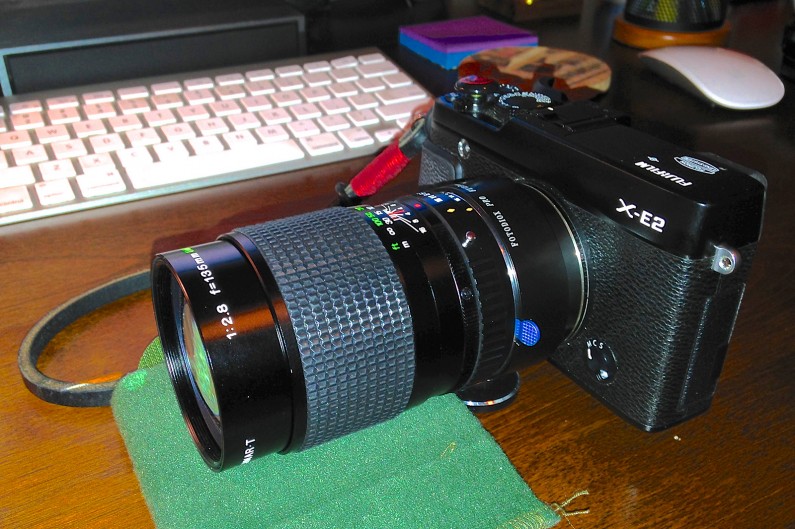

I very much like the appearance of this lens on my X-E2, & the weight & balance of it is just about perfect. With the X-E2 at 350 grams & this lens at 290 grams, the total combined is still quite a bit less than my former Nikon D7000 camera body alone (690 grams). And the lens weight is also less than that for the Leica 135mm I was considering (505 grams). However, like the Leica, it is all metal construction, employing four lenses in four groups, & has a built-in, slide out hood that I really appreciate using. (With my Leica Tele-Elmarit 90 mm, it seems like the very effective detachable hood that snaps onto the front is in the way in my bag quite often.)
Not only is this lens brand new for all practical purposes, it must have been stored in someone’s climate controlled vault, as the exterior condition & optics are pristine. Not a spec of dust, any haze, fungus, scratch or damage of any kind; nor is there any evident wear & tear. I would have to think it was never even a demo or probably not ever mounted on a camera. The bayonet mount is completely unmarked & appears unscathed. Also the aperture & focus rings turn as smoothly as can be, & aperture selections click right into place. The engraved aperture values are a bit small & the aperture ring somewhat fiddly in its location close in to the mount; & it lacks the ½ or 1/3 stops of newer lenses. But the large waffle gripped focus ring is extremely precise in its adjustments & can be operated with one finger if needed. Also it came with shiny, new caps for both ends of it, along with a new black leather case-like bag for storage.
So yesterday I had signed up to go out with my local camera club on a shoot in a local shopping district near Palm Springs called “El Paseo”. It is kind of this area’s “Rodeo Drive”, with all of the upscale shops that folks burdened with camera needs (or maybe debt) probably never visit in any event. But they have installed some incredible statuary in a lengthy divided street, & the architecture of the buildings is quite interesting as well. I decided I would take only the new Fujinon 135mm lens & give it a test using it only wide open to assess its’ sharpness & out of focus areas. Since most of the 135mm focal length tele’s I had considered (including the Leica) were in the f3.5-4.5 aperture range, I was most interested to see what this f2.8 lens could do when opened up.
Set out below are some of the very first images that I have taken with this lens, & overall I can say that I am not disappointed in the least. This lens has a physical look & feel, as well as an ease of use that is very much like that of my Leica 90mm; so I think the learning curve for it will be a fairly short one. However, the magnification range difference between these two lenses is something that requires more physical movement on my part in order to frame an image. The 90mm in effect sees like a 2.7X binocular & the 135mm sees like a 4X binocular, when calculated in full frame equivalent terms. So this difference in the power of magnification is quite noticeable & requires a bit more conscious effort to adapt into my work flow.
Much like the 90mm, I suppose many would say this is ideally a portrait lens. And I am sure that this would be an excellent application for it. For portraiture discussion purposes, it is my understanding that our brains tend to see or reconstruct the images of people as how they would look at about 3 meters or 15 feet of distance, no matter how far or close we might actually be. Our camera lenses can’t make this same adjustment, which is why if we get too close the person’s nose becomes too big & the ears disappear, but when too far away the facial features become flattened. So if we work at about this same 3M distance from a person, the 90mm would produce a very accurate image, & be able to capture the head down to about mid torso; the 135mm image at this distance would be equally accurate but only able to capture the head & upper shoulders. Obviously a fairly small adjustment in the physical distance from lens to subject matter could make these two lenses quite alike, albeit both resulting in some minor distortion of such subjects. So for me at least, there probably isn’t enough difference between them to prefer one over the other for portraiture, but then that isn’t my real objective in any event.
Photos like those taken yesterday, & plans to use it for general landscape, architecture or travel work are more of what I have in mind for it. And overall I am very pleased with these first photos, looking forward to spending much more time with this lens, & testing out the results that can be obtained when stopping down a bit more. Though I do suspect that when doing this there may be a bit more of a problem with diffraction reducing image sharpness with the smallest lens openings. However, since the sharpness even wide open is quite acceptable to me, it will be interesting to see if there might even be some improvements in the mid range apertures. Here are these first photos for you to see what you think.
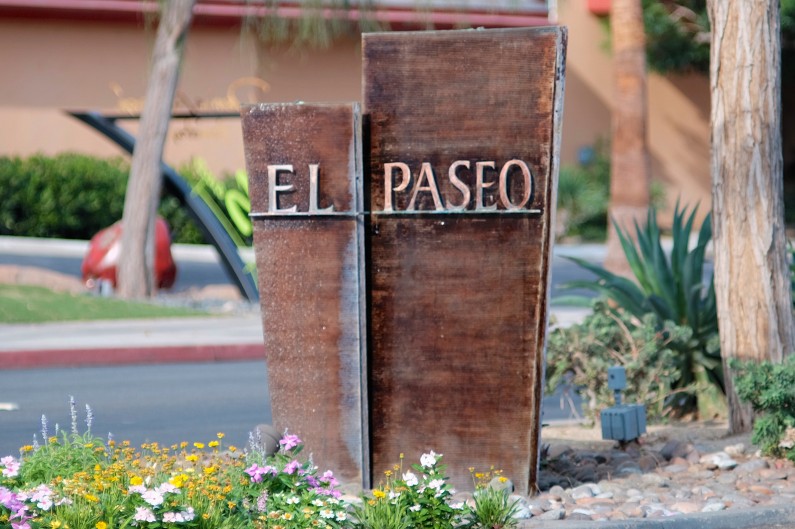

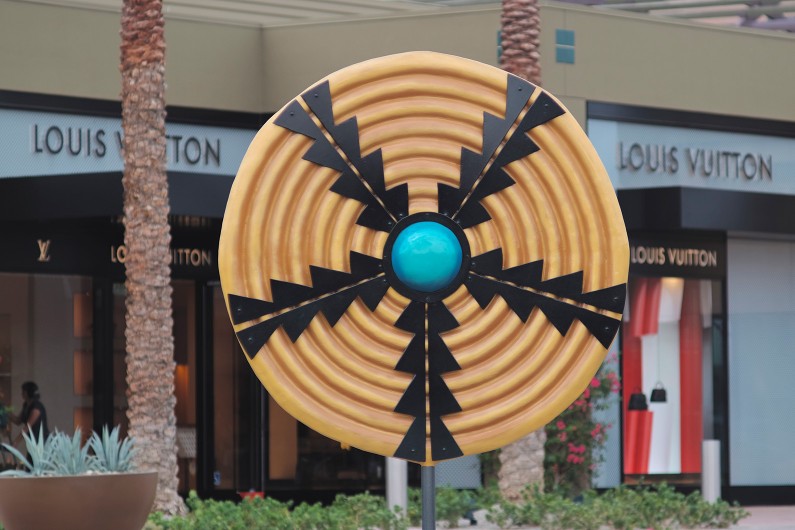
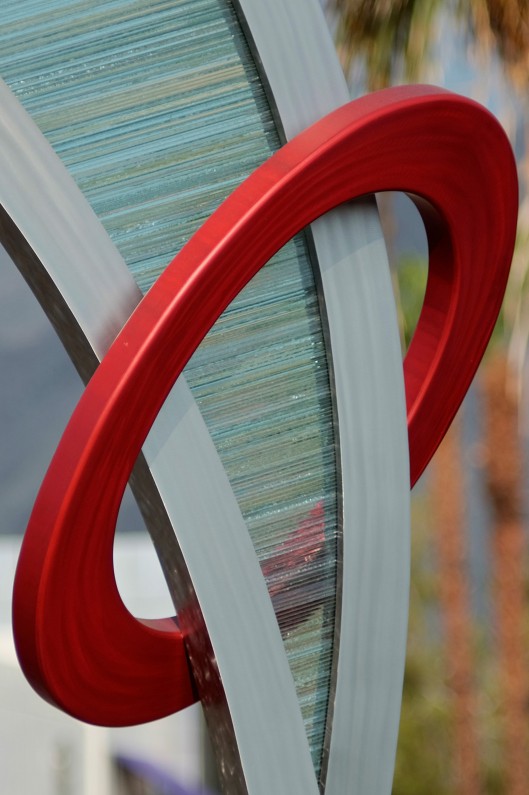
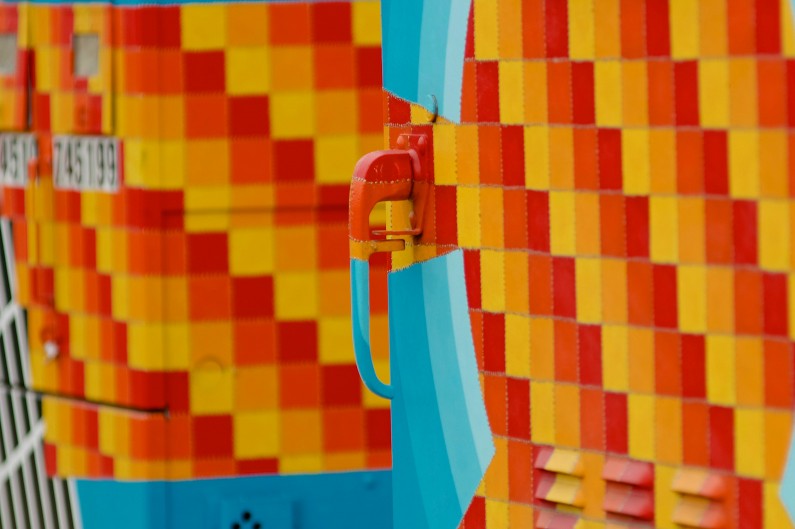
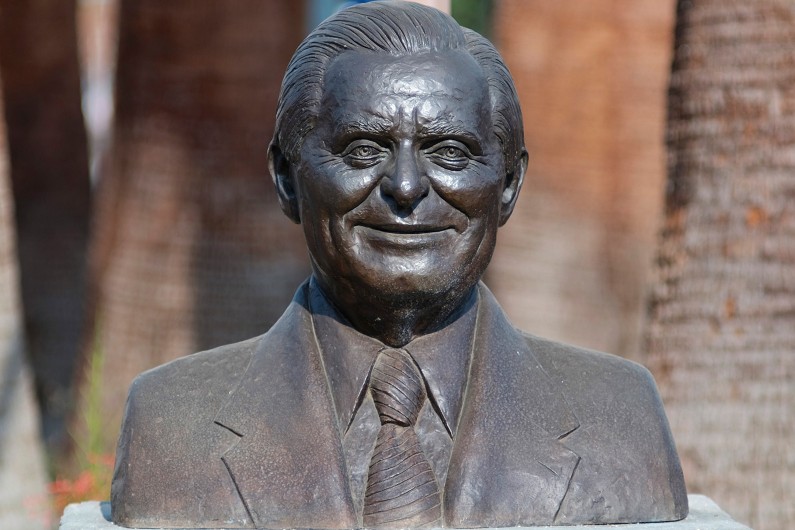
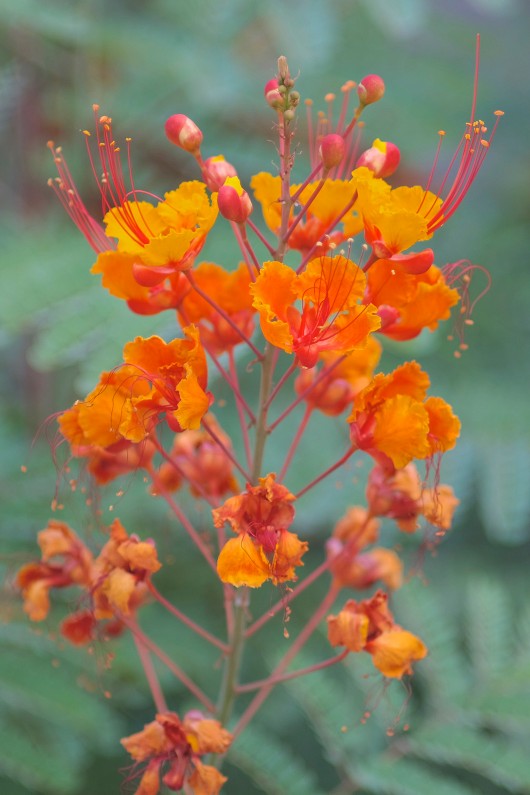
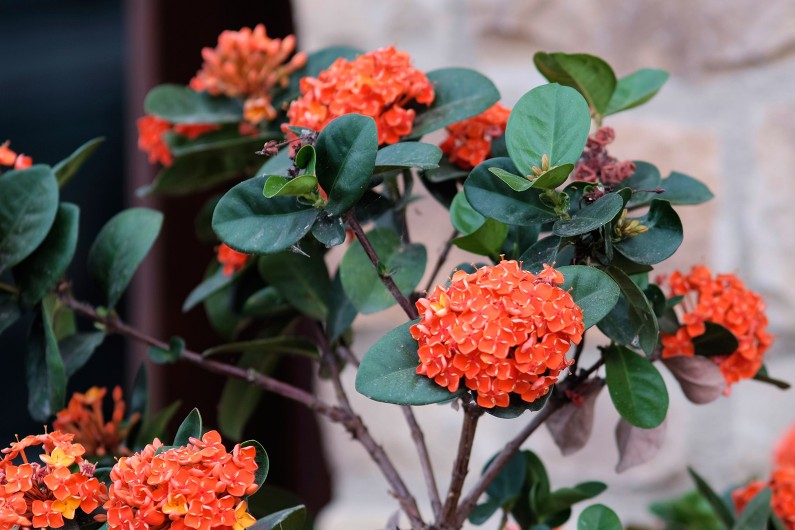
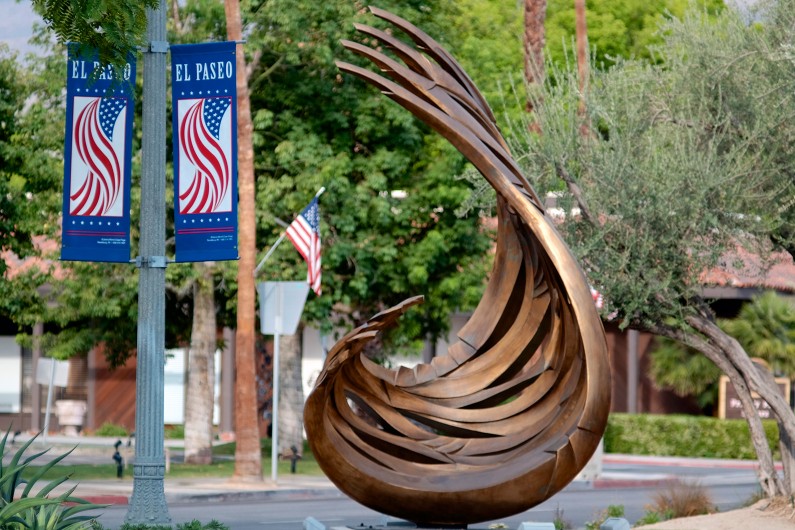
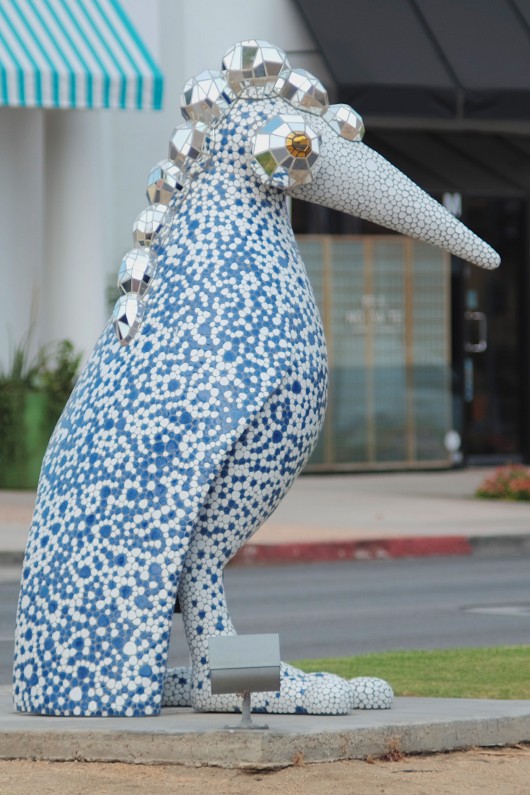
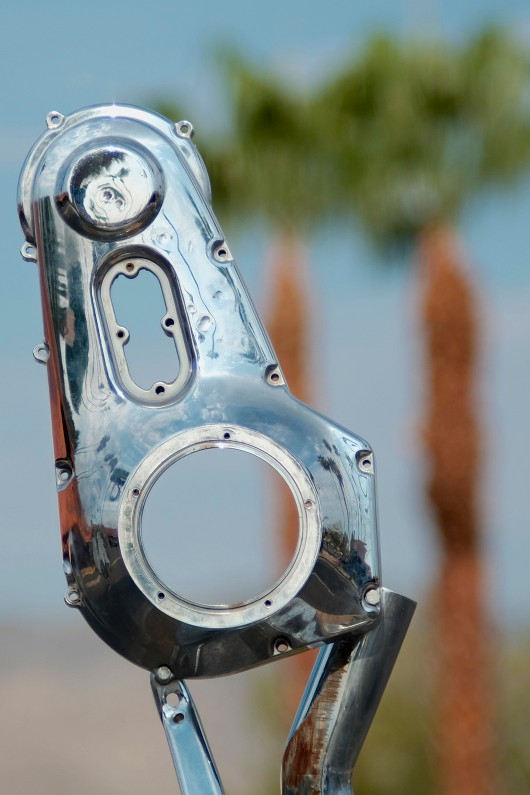
One of the things that struck me the most about this lens was how very simple & enjoyable it was to use with manual focus only, especially with the assists provided by the magnification & focus peaking features of the X-E2 camera. This is also certainly true of my experiences with both the Leica 90mm & Zeiss 50mm, so perhaps it should not come as any real surprise. But at the very least it now gives me more encouragement to consider maybe even looking at the apparently excellent quality Fujinon 200mm f4.5 lens that was also made at the same time as the 135mm – back in the early 1980’s. However, I do know that in looking to find this first Fujinon, I only saw a couple of the 200mm ones; & they were fairly pricey & only available out of this country (i.e., the US, thereby giving rise to customs clearance & duty concerns).
But I will say that if I continue to enjoy this 135mm as much as I think I am going to, & if the work product stays the same or even slightly improved, I will be very, very interested in trying to locate one of the Fujinon 200mm lenses. And if things happen that way, I would like nothing better than to offer another write up for Patrick to consider using on his excellent blog. It was in reading his blog that started my initial thinking about adapted lenses in my quest for a rangefinder like experience with a Fuji camera in the first place. So perhaps there may be more to come, but many thanks for reading what I have had to say about this great, old-like new Fuji lens. And as I will also do, please continue to enjoy the many other good things to be found on “Finding Range.”
Note from Admin: Thanks again, Jed for this interesting article about adapting the vintage Fujinon 135mm f2.8 lens on the Fuji X-E2! I am definitely looking forward to your Fujinon 200mm lens article! I think this is so neat, especially since it also doesn’t cost an arm and a leg :).


“Old lenses never die ….” They just get adapted! Fine job Jed; the possibilities do indeed seem endless.
Inthedarkroom – How very true about old lenses! I just wish my resources were as endless. But then it would be overwhelming I guess; bad enough now deciding what to take where. Some of these old Fuji choices though are quite excellent. Thanks for reading it & commenting.
One of the things which attracted me to mirrorless after many years of SLR use was the availability of adaptors to use a seemingly unlimited range of lenses designed for all manner of other cameras. I have a range of lenses for 9 different mounts at last count, and I too have invested in the Fuji X system. One of my lens collection is a Nikkor-Q 13.5cm f3.5 designed, not for a Nikon body, but for a Leica screw-mount body. It is made in chrome-plated brass and weighs 556 grams on its own. Fortunately it has a built-in tripod mount, as it is not easy to hold steady.
Peter,
You must be well organized to manage your different lenses & their varied adapters. When I had my DSLR I didn’t even think about the possibility of other makes of lenses being used with it, but your are right that mirrorless really seemed to open up this possibility. I suppose Leica with its’ M mounts being made by Zeiss & Voigtlander had been doing it for a while. The Nikkor-Q you describe sounds like a handful – literally! Thanks for reading & commenting. Cheers.
Hi Jed,
your patience and research helped you to get a real good deal. I like the images a lot. Optically a nice fit to the Fuji sensor. And i would never have guessed what camera/lens combo this is looking at them. It is a mix of modern and classic and it shows. As good as Fuji lenses are, sometimes i find the results a bit overdone. Too sharp, too colorful, too much of everything. But that is only me 😉 I guess you did not have lots of work in postprocessing. They pretty much look like how i would expect them to look without any postprocessing. Natural. Considering the price of the lens (or even the combination of both, lens and camera) it is almost too good to be true. Congrats.
Hello Markus,
Initially I was disappointed that I couldn’t find a Leica 135mm, but now I am kind of glad that it caused me to discover this great old Fuji lens, particularly for the incredibly low price . All of these photos were done as a test wide open to see how good f2.8 might be, so now I am just beginning to find out what the mid range apertures can do. And as you surmised, these are just the JPEG’s with some adjustments in Aperture to shadows, highlights & contrast, & some cropping if needed. But to me, these look a lot like what I would expect from my Leica 90mm Tele-Elmarit on the X-E2 – slightly softer & more natural. And I still can’t believe how well this old glass performs. Maybe there just is something magic about mating the prior & current Fuji technologies together – they seem to know each other. Thank you also for the complements & kind words; they are much appreciated. Cheers,
Jed
Hi Jed
Fuji sold three 135mm lenses in the eighties. The EBC X-Fujinon f2.5 / 135mm, the EBC X-Fujinon f3.5 / 135 mm and the Fujinar f2.8 / 135mm lens. The Fujinar lenses were manufactured for Fuji. They are considered budget lenses, but produce nice images nevertheless. Enjoy your lens!
Rene